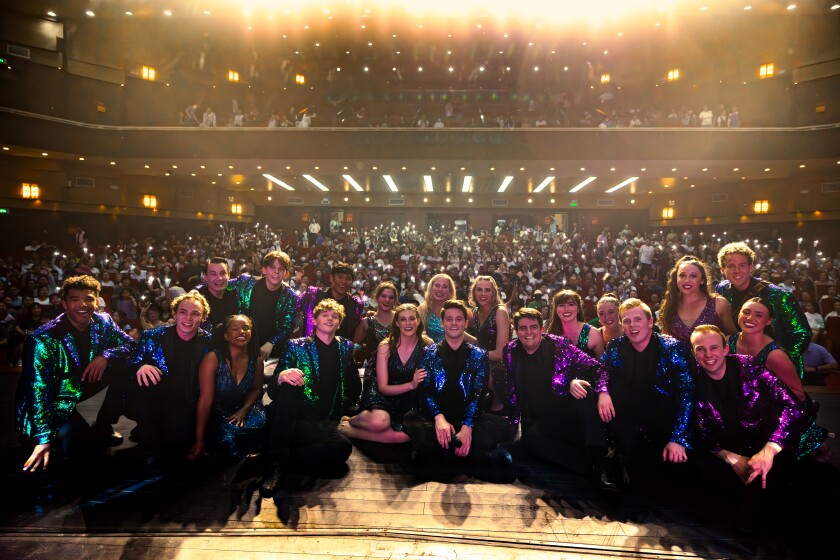2024 Marks 45 Years since BYU’s Young Ambassadors First Toured China and Showcases How the Arts Have Been A Key Part of our Relationship From the Beginning

In early 1979, BYU was given permission to bring a performing group to China. The group consisted of 20 students from the Young Ambassadors and the Lamanite Generation (now Living Legends). 45 years later, new generations of BYU performing groups still tour in China and the relationship between BYU and China continues to grow. In May 2024, the Young Ambassadors returned to China to celebrate the 45th anniversary of this thriving relationship through song and dance.
The relationship between BYU and China started as a prophetic miracle. In 1978, then president of The Church of Jesus Christ of Latter-day Saints, Spencer W. Kimball gave an address that urged church members to “make small beginnings” in foreign nations, including China. Following this guidance, Dallin H. Oaks, BYU president at the time, began making plans to send BYU performing groups to China. Although far-fetched—the United States did not have diplomatic relations with China in 1978—President Oaks’ preparations were rewarded just one year later when, in 1979, diplomatic relations between the countries were established and BYU was granted permission to travel to China.
Since then, BYU has sent performing and academic groups to China. The performing groups rotate between the Young Ambassadors, Living Legends, Ballroom Dance Company and International Folk Dance Ensemble. The Young Ambassadors have toured in China 10 times since 1979.
Nathan Balser, current director of the Young Ambassadors, spoke about the special role the Young Ambassadors play in the relationship between BYU and China and described the experiences students had during their 2024 tour.
Q: What do you think makes the Young Ambassadors unique as a performing group?

Balser: What sets apart the Young Ambassadors (YAs) within BYU is the genre we focus on. We are crafting and performing our shows through a musical theatre lens. So many other amazing BYU arts groups perform to make the world a better place and build the students’ skills but YAs exists as a tool for the university and the Church at large. When they send us out, we shine because we get to serve.
At the most basic level, the YAs are here to serve. Yes, we want to improve by applying our classroom theories and practices, but I try to remind the students that our first priority and purpose is to love and serve others. We rub shoulders with a lot of different people. The shows are a safe and neutral space for people—members and nonmembers—to get to know the university and the Church at large.
I was super impressed with this particular group of students. Any group of people, not just performers, working in close quarters for a long time can bring tensions but I was very grateful to this particular group because they were conscientious of each other and really lovely to each other. I think our Chinese hosts felt that as well.
The tours allow the students to apply and enhance both their academics and their spirituality.
Q: How do international tours like this one benefit the students?
Balser: The students are exposed to the world at large. [In the classroom] we study the world, we study our skills and our craft but to actually go out into the world and experience a different population and be confronted with different personalities and understandings is very valuable for the students. It gives them an appreciation for what they have and also for the majesty of the world and of all of God's children. The tours allow the students to apply and enhance both their academics and their spirituality.
For the students who want to perform as a career, it is also an opportunity to explore what it means to perform under a rigorous schedule. They learn how to take care of themselves and stay healthy during a tour. That experience is hard to gain any other way.
Q: Was there anything unique about this anniversary tour?
Balser: I think it was important that we were there. It was a positive foot forward for our country.
One show in particular was advertised as a family friendly performance so there were many children in the audience; more than at any other show. Included in the ticket sale for that show was a light wand that the children could hold. They were dancing in the aisle with their light sticks and singing out loud. It felt like a rock show. I could see the surprise and joy in our performers’ eyes when they stepped onto stage and heard them.
The best way to communicate with [people] is through music and dance.
Q: What roles does dance and music play in building cross-cultural relationships?
Balser: When [YAs] first started going 45 years ago, their style of performance was completely foreign to the people of China. The Chinese people hadn’t seen or heard any kind of American musical theatre or popular music. Now they have access to American culture but many of the adults there aren’t comfortable speaking English. The best way to communicate with them is through music and dance.
This year we were invited by the government to perform at a cultural event in Xian. The YAs had the first hour of the event to perform and then 200 other performers filled the last hour. The Chinese people value music and dance a lot and they love to exchange with other people. We ended up changing our entire tour schedule to do this important cultural exchange event. They treated us like gold and were so generous and kind. It was great for the students to feel that love.

